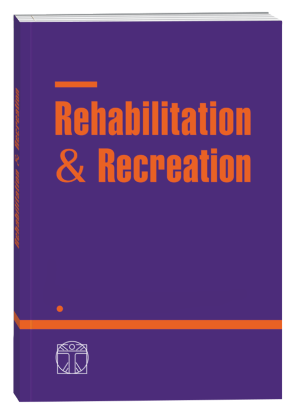COMPLEX RECOVERY AFTER ISCHEMIC STROKE: MANUAL THERAPY AND DIET THERAPY
DOI:
https://doi.org/10.32782/2522-1795.2022.12.1Keywords:
ischemic stroke, manual therapy, diet therapy, manifestations of strokeAbstract
The article provides a theoretical analysis and generalization of the use of methods of manual therapy and dietetics for patients with ischemic stroke. Rather dangerous situation has developed in Ukraine, related to the consequences of a stroke. Unlike many other developed countries, where the disease ranks third among the causes of mortality, in our country it has significantly surpassed oncology and is in second place. The purpose of the study is theoretical substantiation of the use of manual therapy and dietetics in ischemic stroke. Research material and methods. One of the well-known rehabilitation approach is manual therapy, the effect of which is aimed at treating the musculoskeletal system and internal organs using the mechanical action of hands. This practice, which is used by specialists to help restore limb function in people with neurological diseases, was developed for use in stroke patients. Diet therapy is also a very important method of recovery. A properly prescribed diet is the basis for restoring the activity of the brain and the whole body after a stroke. The nutrition program should take into account the physiological features of the human body and the degree of damage to the patient's brain. Research results. The results of the study showed that manual therapy for ischemic stroke improves the movement capabilities of the affected area. Using manual therapy, joint mobility is restored, muscle contracture is weakened, coordination of movements is improved, and muscle condition is improved. Diet therapy after a stroke should consist of high-quality and nutritious products, the sources of which are vitamins, fats, acids, micro- and macroelements, etc. Also, proper nutrition should be aimed at restoring the body and preventing a repeat stroke or the development of diseases of other organs and systems. Conclusions: Manual therapy and diet therapy are effective recovery methods for ischemic stroke. The use of these methods makes it possible to speed up the process of a person's return to his usual way of life.
References
Kamonseki, D. H., Lopes, E. P., van der Meer, H. A., & Calixtre, L. B. (2020). Effectiveness of manual therapy in patients with tension-type headache. A systematic review and meta-analysis. Disability and Rehabilitation, 1-10.
Alvarez, G., Núñez-Cortés, R., Solà, I., Sitjà-Rabert, M., Fort-Vanmeerhaeghe, A., Fernández, C., … & Urrútia, G. (2021). Sample size, study length, and inadequate controls were the most common self-acknowledged limitations in manual therapy trials: A methodological review. Journal of Clinical Epidemiology, 130, 96-106.
da Silva Santos, T., de Oliveira, K. K. B., Martins, L. V., & de Castro Vidal, A. P. (2022). Effects of manual therapy on body posture: Systematic review and meta-analysis. Gait & Posture.
Bialosky, J. E., Beneciuk, J. M., Bishop, M. D., Coronado, R. A., Penza, C. W., Simon, C. B., & George, S. Z. (2018). Unraveling the mechanisms of manual therapy: modeling an approach. journal of orthopaedic & sports physical therapy, 48(1), 8-18.
Fathollahnejad, K., Letafatkar, A., & Hadadnezhad, M. (2019). The effect of manual therapy and stabilizing exercises on forward head and rounded shoulder postures: a six-week intervention with a one-month follow-up study. BMC musculoskeletal disorders, 20(1), 1-8.
Alvarez, G., Sola, I., Sitja-Rabert, M., Fort-Vanmeerhaeghe, A., Gich, I., Fernández, C., … & Urrútia, G. (2020). A methodological review revealed that reporting of trials in manual therapy has not improved over time. Journal of clinical epidemiology, 121, 32-44.
Roh, J. A., Kim, K. I., & Jung, H. J. (2021). The efficacy of manual therapy for chronic obstructive pulmonary disease: A systematic review. PloS one, 16(5), e0251291.
Núñez-Cortés, R., Alvarez, G., Pérez-Bracchiglione, J., Cabanas-Valdés, R., Calvo-Sanz, J., Bonfill, X., & Urrutia, G. (2021). Reporting results in manual therapy clinical trials: a need for improvement. International Journal of Osteopathic Medicine, 42, 92-99.
Bordoni, B., Marelli, F., Morabito, B., & Sacconi, B. (2018). Emission of biophotons and adjustable sounds by the fascial system: review and reflections for manual therapy. Journal of Evidence-Based Integrative Medicine, 23, 2515690X17750750.
Teuschl, Y., Trapl, M., Ratajczak, P., Matz, K., Dachenhausen, A., & Brainin, M. (2018). Systematic dysphagia screening and dietary modifications to reduce stroke-associated pneumonia rates in a stroke-unit. PLoS One, 13(2), e0192142.
Lieber, A. C., Hong, E., Putrino, D., Nistal, D. A., Pan, J. S., & Kellner, C. P. (2018). Nutrition, energy expenditure, dysphagia, and self-efficacy in stroke rehabilitation: a review of the literature. Brain Sciences, 8(12), 218.
Downloads
Published
How to Cite
Issue
Section
License

This work is licensed under a Creative Commons Attribution-NonCommercial-NoDerivatives 4.0 International License.











